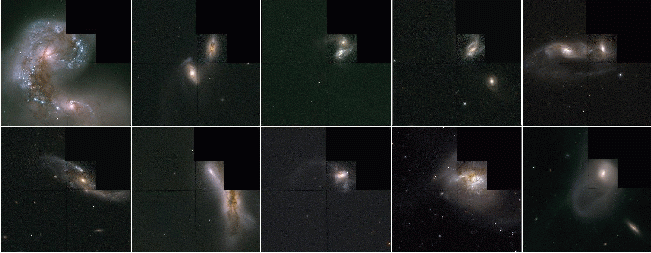 Mosaic to left is a composite from Figure 1 of paper:
HST WFPC truecolor of Toomre Sequence. NGC 4038/9 from
Whitmore & Schweizer (1995, AJ, 109, 960); NGC 3921 from Schweizer et al.
(1996, AJ, 112, 1839); NGC 3256 from Zepf et al. (1999, AJ, AJ, 118, 752);
NGC 7252 from Miller et al. (1997, AJ, 114, 2381);
the remainder from this paper.
Mosaic to left is a composite from Figure 1 of paper:
HST WFPC truecolor of Toomre Sequence. NGC 4038/9 from
Whitmore & Schweizer (1995, AJ, 109, 960); NGC 3921 from Schweizer et al.
(1996, AJ, 112, 1839); NGC 3256 from Zepf et al. (1999, AJ, AJ, 118, 752);
NGC 7252 from Miller et al. (1997, AJ, 114, 2381);
the remainder from this paper.
The Toomre Sequence Revisited with HST NICMOS: Nuclear Brightness
Profiles and Colors of Interacting and Merging Galaxies
We discuss the near-infrared (NIR) properties of the nuclei in the 11 merging galaxies of the Toomre sequence, based on high spatial resolution J, H, and K imaging data using NICMOS on board the Hubble Space Telescope (HST). The observations are less affected by dust extinction than our previous HST WFPC2 observations and offer higher spatial resolution than existing ground-based NIR data. Nuclear positions are generally found to be consistent with those reported from data in other wave bands. In NGC 7764A we detect for the first time two nuclei with a separation of about 260 pc, consistent with its placement in the middle of the merging sequence. We see a marginal trend for the nuclei to become bluer with advancing merger stage, which we attribute to a dispersal of dust at late times in the merging process. Our data also indicate a statistically significant trend for the nuclei in the sequence to become more luminous, within an aperture of fixed physical size and after correcting for dust extinction, with advancing merger stage. We derive K-band surface brightness profiles for those nuclei for which the morphology allows a meaningful isophotal analysis, and fit the profiles with a "Nuker" law for comparison with other samples of galaxies observed with HST. The majority of the nuclei have steep profiles that can be characterized as power-law type. In general, the Toomre-sequence galaxies tend to have steeper profiles and higher central luminosity surface densities than E/S0 galaxies. Our findings can be explained if the Toomre-sequence galaxies have newly formed stars that are concentrated toward their centers. We derive V - K color profiles for the nuclei to further address this possibility, but find that the large amounts of dust extinction complicate their interpretation. Overall, our results are consistent with the generic predictions of N-body simulations of spiral galaxy mergers. If left to evolve and fade for several gigayears, it is possible that the properties of the Toomre-sequence nuclei would resemble the properties of the nuclei of normal E/S0 galaxies. Our results therefore support the view that mergers of spiral galaxies can lead to the formation of early-type galaxies.
Related links: